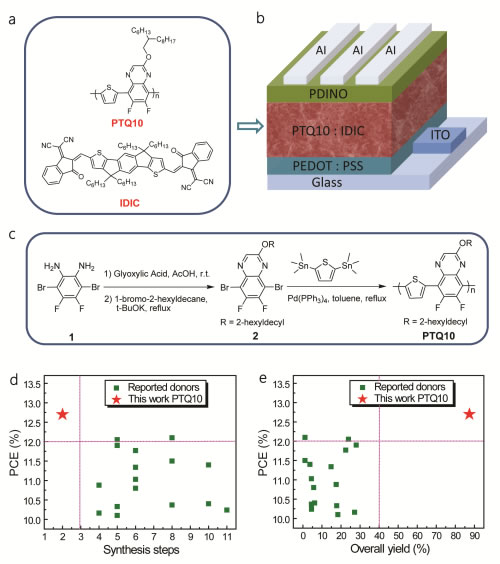Chemistry is making progress on low-cost, high-efficiency polymer-donated photovoltaic materials
The polymer solar cell is composed of a p-type conjugated polymer donor and a fullerene derivative or a non-fullerene n-type organic semiconductor receptor blending active layer sandwiched between a transparent conductive electrode and a metal electrode. With its salient advantages of solution processing, light weight, and flexibility and semi-transparent devices, it has become a hot topic in the global energy field in recent years. Commercial applications of polymer solar cells need to achieve high efficiency, high stability, and low cost of the device, which mainly depends on the development of photovoltaic materials. Since Alan J. Heeger et al. proposed the concept of bulk heterojunction in 1995, the research on polymer solar cell photovoltaic materials and devices has been continuously developed. In the early stages of the study, the efficiency of the device was low. The focus of the study was mainly on improving the efficiency by designing and synthesizing narrow-band, broad-absorption, and polymer-donating photovoltaic materials with lower HOMO levels and higher LUMO. The energy level fullerene derivative accepts photovoltaic materials to increase the short circuit current, open circuit voltage, and energy conversion efficiency of the device. In recent years, with the development of narrow-bandgap non-fullerene n-type organic semiconductor acceptor photovoltaic materials and their complementary absorption of wide band gap polymer donor photovoltaic materials, the energy conversion efficiency of polymer solar cells has rapidly increased, recently The efficiency of small-area devices in the laboratory has exceeded 12-13%, reaching the threshold for practical application. Therefore, to improve the stability and reduce the cost has become the key to the practical application of polymer solar cells. However, most of the high-efficiency photovoltaic materials that have been reported so far are complicated in structure and difficult to synthesize, and it is difficult to meet the needs of commercial applications. The development of low-cost, high-efficiency photovoltaic materials will be a huge challenge for commercial applications of polymer solar cells. Under the support of the National Natural Science Foundation of China and the Chinese Academy of Sciences, researchers from the Chinese Academy of Sciences and the Researcher of the Institute of Chemistry, Chinese Academy of Sciences Key Laboratory of Organic Solids Research Institute Li Yongji recently designed and synthesized a low-cost, high-efficiency polymer donor material PTQ10. (The molecular structure is shown in Figure a). PTQ10 is a structurally simple DA copolymer in which the thiophene ring serves as the donor unit and quinoxaline serves as the acceptor unit. The introduction of alkoxy side chains on the quinoxaline is to increase the solubility of the polymer and enhance light absorption, introduce a substitution of the bi-fluorine atom to reduce the HOMO level of the polymer and increase the hole mobility. This molecule can be synthesized in two steps by inexpensive raw materials (Fig. c) and at the same time achieve an overall yield of approximately 90%, leading to a substantial reduction in the cost of the material. More importantly, the highest energy conversion efficiency of the polymer solar cell (device structure shown in Figure b) prepared using the PTQ10 as the donor and the relatively simple structure of the n-type organic semiconductor IDIC (Figure a) as the acceptor reached 12.70%. At the same time, the efficiency of reverse-structured devices has also reached 12.13% (12% efficiency as confirmed by China Institute of Metrology). At the same time, the device efficiency can exceed 10% with an active layer thickness in the range of 100 nm to 300 nm, which is very favorable for the large-area preparation of devices. Compared with other highly efficient polymer-donated photovoltaic materials reported in the current literature with efficiencies of more than 10%, PTQ10 has a very outstanding advantage in terms of synthesis steps, yield, and efficiency (Fig. d, e). Considering the advantages of low cost, high efficiency and thickness insensitivity, PTQ10 is very promising as a polymer donor material for commercial applications of polymer solar cells. This work was published in Nature-Communications on February 21st (Nat. Commun. 2018, 9, 743). (a) Molecular structure of donor PTQ10 and receptor IDIC; (b) Cell device structure diagram; (c) Synthesis route of PTQ10; (d) and (e) Polymer solar cell donor material synthesis steps, yield, and Efficiency comparison and analysis diagram. ChangChun E-vida Technology Co.,ltd , https://www.evidatech.com